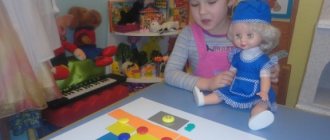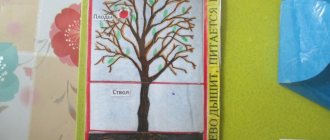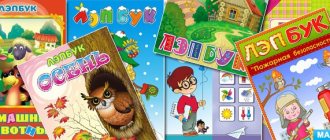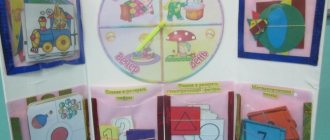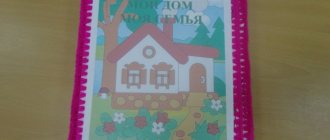Speech development is a complex, multifaceted process that is closely related to the formation and development of human mental processes.
Mastering the native language as a means and way of communication and knowledge is one of the most important acquisitions of a child. This problem is at the center of many modern studies. In the first years of life, speech first acts as a means of communication and designation, then it becomes a tool of thinking, expressing thoughts, and organizes human activity and behavior (L. S. Vygotsky, 1983; A. R. Luria, 1956, etc.
In recent years, there has been a decline in the level of speech development of preschool children. This is facilitated by a number of reasons, which include the deterioration of children’s health, the global decline in the level of speech culture in society, and the passivity and ignorance of parents in matters of children’s speech development, which most often manifests itself in the imbalance of family education in matters of speech development, which manifests itself either in the desire for early learning of written language at the expense of oral, or in an indifferent attitude towards it.
The participation of parents in the speech development of the child plays a colossal role.
In children with OSD, speech does not develop independently. The process of accumulation, selection of words and handling them in speech activity suffers (the dictionary is chaotic and unorganized). All this leads to a decrease in attention, memory, and cognitive processes of perception.
Speech formation is one of the main tasks of speech education of a preschooler, because plays a big role in the formation of personality. To develop a child’s speech, you should use various games, activities, manuals, and innovative technologies. In connection with the implementation of the Federal State Educational Standard for preschool educational institutions, teachers are looking for new approaches, ideas, and teaching methods in order to meet modern requirements for the education and upbringing of preschool children.
In the context of the implementation of the new Federal State Educational Standard (FSES), working with children with general speech underdevelopment and facing problems in their learning, a teacher-speech therapist has to look for aids that facilitate, systematize and guide the process of mastering new material. A speech therapist teacher must show mobility, variability and creativity in choosing educational technologies that will help each child show his interests and needs, and also involve his parents in the correction process.
Proper organization of education for children with special needs is a very difficult matter. Therefore, along with generally accepted techniques and principles, it is entirely justified to use original, creative methods, the effectiveness of which is obvious.
In my opinion, the introduction of new approaches to the development of preschoolers with special needs should not contribute to replacing traditional methods, but to expanding their capabilities. Therefore, in my work with such children I use both traditional and modern educational technologies, which I effectively use in joint activities with children, as well as with their parents.
One of such teaching aids for today's preschoolers is a lapbook or, in other words, a thematic or interactive folder. This folder collects material on a specific topic.
A laptop is interesting and useful because it is made jointly by an adult and children.
A laptop is a relatively new phenomenon; it is a folding book with pockets, doors, windows, tabs and moving parts, in which materials on one topic are placed. A laptop helps a child organize information on the topic being studied at will and better understand and remember the material (especially considering that the thinking of children in preschool age is visual and figurative in nature).
Lapbook literally translated from English means “knee book.” The laptop is a relatively new learning tool.
In children with speech disorders, speech does not develop independently. The process of accumulating words and using them in speech activity suffers. The path to correcting sound pronunciation is difficult and lengthy. As mentioned above, preschoolers in this category also suffer from cognitive processes: memory, attention, perception, thinking.
The solution to these problems is the use of a laptop in speech correction work.
This interactive folder allows you to:
· replenish children's vocabulary and expand the “semantic fields” of word meanings;
· speed up and make the process of automation and differentiation of sounds more attractive;
· form grammatical categories;
· develop coherent speech;
· form the psychological basis of speech;
· improve fine motor skills.
For us, a lapbook is a unique means of collaboration with children; it is an excellent way to consolidate and repeat material. By combining play, learning and education into one process, a lapbook makes it possible to build work on speech development with children with speech impairments, taking into account the individual characteristics of the child, to create conditions under which the child independently consolidates the acquired knowledge in the form of a game, and also, importantly, develops speech skills.
At the first stage, we studied the limited experience of domestic teachers on this topic using Internet resources.
At the second stage, based on the analysis of the studied materials, a test laptop was made. The children were interested in the lapbook. Our children have been familiar with laptops and netbooks since childhood. The word “lapbook” is consonant with these terms, which means that it also contains a lot of interesting and useful information. And the main thing is that you can touch, feel, explore all the pockets and envelopes!
At the third stage, together with the children, they began to develop and use their own lapbook: “Animals of Africa.” The making of a lapbook was preceded by thematic activities and games, discussion and assignments. The child remembers information, draws diagrams of the layout of games in a book, learns to plan, explore, and design. With such work, the lapbook really fulfills its role as a reinforcing, didactic and gaming aid.
It is not necessary for the child to complete all tasks at once. Many of them are designed for long-term work, studying additional information and conducting their own research. Therefore, you need to return to the lapbook more than once, which means playing and studying.
In addition to educational advantages, a lapbook can be perceived by preschoolers as a “treasure” to which it is interesting to return, leaf through and revise information, remembering it and accumulating it in their memory. Therefore, when the created “treasure” is demonstrated to peers, spontaneous discussions and debates occur, which help improve the assimilation of information, as well as the development of monologue and dialogic speech of children.
The use of a lapbook in speech therapy work with preschoolers with special needs as an independent teaching aid can be used in any preschool educational institutions. This technology touches on the current and sought-after topic of speech development in children with special needs and allows you to build a system of work on the development of the lexical and grammatical structure of speech, reveal children's initiative and organize effective cooperation with the family.
An important and integral part of the work to eliminate speech disorders in children is the close interaction of parents in matters of pathology and speech correction, their underestimation of the early detection of speech defects and timely intervention on them, incorrect and sometimes harmful attitudes regarding the speech of children, indicate the need for all stages of correction. Parental help is extremely important. Firstly, parental opinion is the most authoritative for the child, and secondly, only parents have the opportunity to daily consolidate the skills they are developing in the process of live, direct communication with their children.
Creating a lapbook is one of the types of joint interactive activities between adults and children. This is expressed in the fact that parents, together with their children, look for the necessary material on a certain topic, be it riddles or pictures cut out from a magazine. The child should take an active part in the selection of material, and not remain on the sidelines. During the joint search, parents and the child communicate simultaneously.
A laptop can also be a form of presenting the results of a project or a thematic week. In the future, the child will learn to independently collect and organize information - this is good preparation for research activities.
The construction of a system of speech therapy work using the creation of a laptop for the development of the lexical and grammatical structure of the speech of school-age children with SLD was based on the following principles:
· the principle of individualization, taking into account the capabilities, developmental characteristics and needs of each child
· the principle of supporting children's initiative and shaping the cognitive interests of each child;
· the principle of specificity and accessibility of educational material, compliance of requirements, methods, techniques and conditions of education with the individual and age characteristics of children;
· the principle of recognizing each child as a full participant in the educational process;
· the principle of systematicity and interconnection of educational material;
· the principle of integrating the efforts of specialists;
· the principle of concentric build-up of information in each of the subsequent age groups in all five educational areas;
· the principle of gradual presentation of educational material.
In my work, I use lapbooks in individual and subgroup lessons on correcting sound pronunciation, forming lexical and grammatical categories and developing coherent speech. I also suggest that children use cards and games from laptops in free activities to automate the sounds. Children often take one or another laptop home to once again “plunge” into one or another lexical topic with their parents.
Thus, in addition to information and communication technologies, which are actively being introduced into the educational process and replacing the live emotional communication of children with adults, with parents, and children with each other, there is a wonderful modern accessible learning tool that facilitates the interaction of all participants in the educational process - the lapbook. It promotes the creative development of all participants in the pedagogical process.
Lapbook “Welcome to Zvukobookgrad”
The lapbook “Welcome to Zvukobukvagrad” reflects the following sections and applications:
City of sounds and letters
(Annex 1)
Tasks:
a general idea of the sound-letter system.
Section “Preparation for literacy training”
(application 2)
pictures for different sounds (Game “Find the picture with the given sound”)
green and blue letters (Game “Match the letter for the sound”)
numbers
counting material (fish) (Game “How many sounds in a word”)
sound articulation analysis diagram
sound schemes (Game "", "Sound schemes"
- selection of a certain sound scheme to the picture and vice versa from the picture to the scheme.)
sentence schemes (Games “Come up with a sentence with a picture”, “Find a suitable sentence scheme”)
word schemes (Game "Train Train")
- determining the place of a sound in a word;
Tasks:
consolidation of speech units: “sound”, “syllable”, “word”, “sentence””; dividing words into syllables; analysis of the position of the organs of articulation when pronouncing speech sounds for their subsequent characterization and sound analysis; sound-letter analysis (differentiation of vowels and consonants of hard and soft sounds); formation and consolidation of a graphic image of a letter, reading skills
development of phonemic hearing; analysis and synthesis of proposals.
3. Section “Sound Pronunciation”
(Appendix 3)
Game “Hang up a picture with the right sound”
Pure phrases with visual support for different sounds
Phonemic jokes on differentiating sounds
Game "Collect the picture"
(cut pictures with individual syllables making up a whole word).
Tasks :
-
automate and differentiate the necessary sounds, develop and improve phonemic hearing; formation and consolidation of knowledge about dividing words into syllables, syllabic analysis and synthesis.
4. Section “Games with letters”
(Appendix 4)
Tasks:
formation and consolidation of phonemic hearing, graphic image of a letter, syllable reading skills, sound-letter analysis and synthesis; development of memory, attention, logical thinking.
Game “What does a letter look like”
(development of imagination, associative thinking)
Game "Fold the letter" (
development of tactile sensations); material for laying out letters: fabric, colored threads, counting sticks)
Game "Syllable Daisy"
(reading syllables)
Game "Read the word"
(signed picture)
Game "Finish the word"
(the first syllable is written according to the picture, the child must name the missing syllable).
Game "Read the first letter of the word."
The game reinforces the ability to identify the first sound in a word and write it using a letter, reading skills, and sound-letter analysis. Progress of the game: the child is asked to read words from the first letters of the pictures and compose them orally or from a set of letters.

